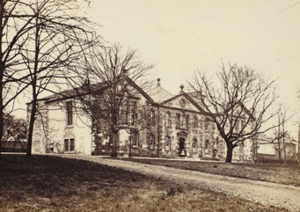John Glassford facts for kids
John Glassford (born 1715, died 1783) was a very important Scottish businessman. People at the time thought he was the greatest of the "Tobacco Lords." These were powerful merchants in Scotland who made huge fortunes from the tobacco trade. John Glassford owned large tobacco farms, called plantations, in places like Virginia and Maryland in America. Because of this, his name is strongly connected to Glasgow's history with the slave trade.
Contents
Who Was John Glassford?
John Glassford was born in Paisley, Scotland. He was the third son in his family. As he grew up, he married three times, each time to women from important families. His great wealth allowed him to buy or build many large homes around Glasgow. Some of his most famous properties were Whitehill, Shawfield, and Dougalston. He loved improving his homes, especially the Dougalston estate. There, he planted many trees, built new structures, and even created an artificial lake called Dougalston Loch.
A famous painting from 1766, called the Glassford Family Portrait, shows him with his family. It's now in Glasgow's People's Palace. The painting shows them in their city home, the Shawfield Mansion. This house was located where Glassford Street is today, a street named after him. John Glassford had fourteen children, but only eight lived to be adults. The painting also subtly shows a Black servant, which reminds us of Glassford's connection to the slave trade.
The Tobacco Trade in Glasgow
From about 1710, Glasgow became a very busy and rich city. This was thanks to the tobacco trade, which lasted for almost fifty years. The people who made their money from this trade were known as the "Tobacco Lords." They were the new rich people of the mid-1700s.
In 1742, John Glassford started working with his brother-in-law, Archibald Ingram, at a fabric printing factory. Later, around 1745, he bought the old Shawfield Mansion. This house had been damaged during the Malt tax riots in 1726. Glassford bought it mainly for the land it was on, which is now the site of Glassford Street. On Christmas Day in 1745, Bonnie Prince Charlie stayed at the ruined Shawfield Mansion for ten days. Around 1760, Glassford also built Whitehill House, which was north-east of Glasgow.
Glassford officially joined the tobacco trade in 1750. He and Archibald Ingram created a company called Ingram & Glassford. John Glassford quickly became very successful. He owned many ships and had tobacco stores all over New England in America. People at the time said he was the biggest ship owner in Scotland. He was one of four merchants who helped Glasgow become a major trading city through the tobacco business.
A writer named Tobias Smollett met Glassford in 1771 and wrote about him:
I talked with Mr. Glassford, who I think is one of the greatest merchants in Europe. During the last war, he was said to own twenty-five ships and their goods at one time. He traded for more than half a million pounds a year.
Glassford's business was not just about tobacco from the colonies. He also supported many manufacturing businesses in Glasgow. He was a main partner in important banks like the Glasgow Arms and Thistle Banks. However, the tobacco trade eventually led to his financial problems. The American Revolutionary War (1775–1783) stopped Glasgow's tobacco trade. While some other Tobacco Lords sold their businesses before the crash, Glassford did not.
John Glassford died at his home, Shawfield Mansion, on August 27, 1783. He had debts of over £93,000 when he passed away. He is buried in Ramshorn Cemetery in Glasgow.
Glassford's Family
John Glassford married the sister of Archibald Ingram. This was either his first or second wife.
His third wife was Margaret Mackenzie. She was the sixth daughter of George Mackenzie, 3rd Earl of Cromartie. With Margaret, he had three children who survived:
- James, who became a lawyer and died in 1845.
- Isabella
- Euphemia
Glassford's Lasting Impact
Even though John Glassford was one of Glasgow's most important 'tobacco lords,' he is not as widely remembered today as you might expect. In 1881, a writer named George Stewart noted that Glassford, who was once "the very prince of Glasgow merchants," was "now almost forgotten." Despite this, his work greatly shaped Glasgow's trading history.


